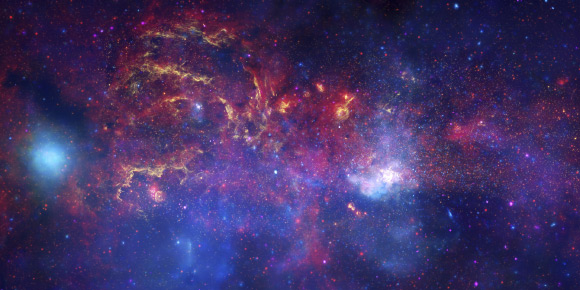Australian National University astrophysicist Dr. Roland Crocker and his colleagues from Europe, New Zealand, Australia and the United States have shown how most of the Galactic antimatter forms.

This composite image shows the central region of the Milky Way Galaxy. Image credit: NASA / JPL-Caltech / ESA / CXC / STScI.
Antimatter is material composed of the antiparticle partners of ordinary matter — when antimatter meets with matter, they quickly annihilate each other to form a burst of energy in the form of gamma-rays.
Astrophysicists have known since the early 1970s that the inner parts of the Milky Way Galaxy are a strong source of gamma-rays, indicating the presence of antimatter, but there had been no settled view on where the antimatter came from.
“Our team had shown that the cause was a series of weak supernova explosions over millions of years, each created by the convergence of two white dwarfs which are ultra-compact remnants of stars no larger than two suns,” Dr. Crocker said.
“Our research provides new insight into a part of the Milky Way where we find some of the oldest stars in our Galaxy.”
He said the team had ruled out the supermassive black hole at the Milky Way’s center and the still-mysterious dark matter as being the sources of the antimatter.
The antimatter came from a system where two low-mass white dwarfs form a binary system and collide with each other.
The smaller of the two dwarfs loses mass to the larger star and ends its life as a helium white dwarf, while the larger star ends as a carbon-oxygen white dwarf.
“The binary system is granted one final moment of extreme drama: as the white dwarfs orbit each other, the system loses energy to gravitational waves causing them to spiral closer and closer to each other,” Dr. Crocker said.
“Once they became too close the carbon-oxygen white dwarf ripped apart the companion star whose helium quickly formed a dense shell covering the bigger star, quickly leading to a thermonuclear supernova (known as SN 1991bg-like) that was the source of the antimatter.”
The research was published online May 22, 2017 in the journal Nature Astronomy.
_____
Roland M. Crocker et al. 2017. Diffuse Galactic antimatter from faint thermonuclear supernovae in old stellar populations. Nature Astronomy 1, article number: 0135; doi: 10.1038/s41550-017-0135







